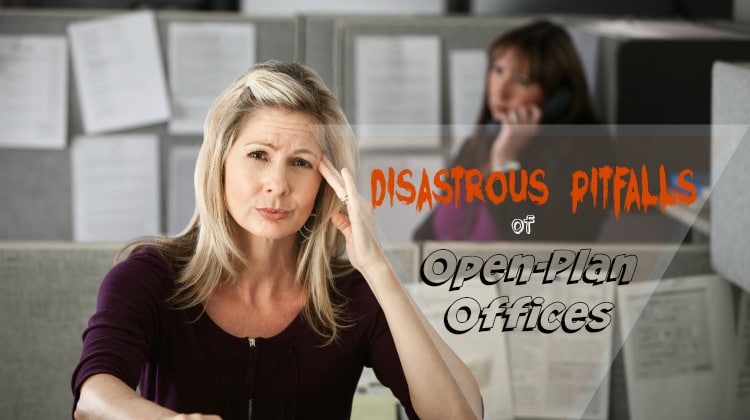
Remember when the open-plan office concept became the hot new trend? Cool companies “got it” and tore down the walls. Everyone worked at miniature desks with no obstructions between employees so they could easily interact throughout the day. Those cool companies boasted increased productivity, improved collaboration, stronger company cultures (before company culture became a buzzword, itself), and happier employees.
Turns out, open-plan offices aren’t all they’re cracked up to be according to the data. Loud coworkers, sick coworkers, and constant distractions can actually have the exact opposite impact on a company than what all the cool companies were hyping.
The infographic at the end of this article provides data and insights about the detrimental pitfalls of open-plan offices, which can be lumped into five problem areas that directly affect a company and its employees:
1. Reduced Productivity
It’s a lot easier to interrupt the person sitting next to you with a quick question than it is to get up and walk across the room or building to ask that person your question (or to look for the answer yourself). All of those intentional interruptions lead to significantly reduced productivity.
Open-plan offices not only make it too easy for people to intentionally interrupt each other throughout the day, but open offices also make it impossible to shut out unintentional interruptions like colleagues on their phones, chatting with each other about where to go to lunch, coughing, chewing, banging the keys on their keyboards loudly, and so on. Even an unusual laugh or a loud breather could turn into nails on a chalkboard for some people when they can’t get away from it. All of these unintentional distractions lead to reduced productivity, which hurts the company’s bottom-line.
2. More Mistakes
Distractions cause employees to lose focus, and a lack of focus leads to mistakes. Not only do mistakes mean lower efficiency but they can also cause big problems that can lead to lost revenue. Everyone makes mistakes. We’re human. However, when you’re constantly distracted, you’ll make more mistakes. You’re human.
Don’t believe me? Try to drive a car filled with kids and see how distracted you get. School bus drivers are truly amazing people.
3. Increased Sickness
When employees work more closely together physically, it doesn’t take a degree in medicine to know that it’s a lot easier for germs to spread between those people. That means more employees get sick more often, and more sickness leads to more sick days.
What happens when workers don’t show up for work? Overall productivity goes down, coworkers get frustrated, and ultimately, the company loses money.
4. More Stress
How do you feel when everyone around you can hear what you’re doing? How do you feel when the person next to you talks so loudly on their phone that you can’t think? How do you feel when the person sitting an arm’s length away from you is sneezing and coughing like crazy?
If you’re like most people, you probably feel stressed. Too much information and too much “closeness” is not a good thing, so it’s not surprising that research has found open-plan offices increase employee stress.
5. Higher Costs
Did you read 1-4 above? What do they have in common? If you said, “They all cause a company to lose time, which means they lose money,” you’re right. Reduced productivity, increased mistakes, more sickness, and higher levels of stress all lead to higher costs and lost money for a company.
Check out more statistics about the negatives of open-plan offices in the infographic from GetVOIP below. Have you worked in an open office? Leave a comment and share your experience.





